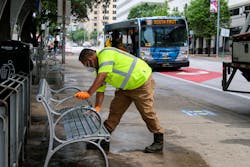The New Passenger Experience: In a COVID-19 World, Communicating about Cleanliness is Key
In a research paper first published April 13, 2020, Jeffrey E. Harris, a professor at the Massachusetts Institute of Technology, called the New York City Transit subway a “major disseminator—if not the principal transmission vehicle—of coronavirus infection” when COVID-19 was first spreading throughout the city in March. While this paper has since been rebutted in various publications such as The Atlantic, The New York Times and Vice, the paper was picked up by several local media outlets like The New York Post and The New York Daily News, causing debate over the safety of public transit at large.
The spread of misinformation has meant public transit has had to work harder at getting its core message out: Transit is still here, and it’s here to serve the community.
“We’re trying to get as many people aware of how safe we actually are during this pandemic,” said Capital Metro (CapMetro) President and CEO Randy Clarke. “Part of that is dispelling so many people with the notion that transit is unsafe. I refer a lot to Hong Kong, where Hong Kong has seven deaths from COVID-19, and they move five and a half million people a day in the subway.”
With these new concerns in mind, agencies are working to reshape the passenger experience by implementing new customer experience initiatives with a focus on cleanliness, informing the public about these initiatives and identifying new metrics to show the value transit adds to the community.
Cleanliness and Safety Go Hand-in-Hand
Cleanliness has always been a part of safety, but now it has taken a front seat, pushing agencies to implement more robust cleaning measures and other initiatives to enhance the customer experience.
“Cleanliness skyrocketed as a top measure of safety,” said Laura Koprowski, chief communication and customer experience officer, Toledo Area Regional Transit Authority (TARTA).
John Sisson, CEO, Delaware Transit Corporation (DTC), operating as DART First State Transit Services, added, “We started ramping up our cleaning operations, along with doing a vital oxide spray once every couple of weeks on the buses. Most recently, we’ve stationed a contractor out at our major transit hubs, and midday they’re coming on the buses and wiping down high-touch areas.”
In addition to updated cleaning protocols, agencies are also implementing customer experience initiatives such as the New York Metropolitan Transportation Authority installing mask dispensers on buses, CapMetro replacing its fabric seating material on all its buses and the Regional Transportation Commission (RTC) of Southern Nevada upgrading its CAD/AVL system to post live passenger counts in real time.
“While they’re waiting for a bus, [passengers] will have real-time information as to when the bus will reach maximum capacity, so they can determine whether they want to get on the bus or wait for the next one,” said MJ Maynard, transportation commissioner, RTC.
Some initiatives, specifically ones focused on technology improvements such as real-time information and contactless fare payments, are being accelerated. For instance, CapMetro already has a contactless payment option and was in the process of installing all-door boarding validators prior to the pandemic. Now, that effort has been accelerated and is expected to be completed by mid-fall.
Communicating with Riders to Win Back Trust
With these new safety measures in place, agencies have found it just as important to communicate these efforts with their community.
“Now that we’re in the middle of this health crisis, we understand that we’re going to shift the messaging because we have certainly enhanced our cleaning processes,” said Maynard. “If we don’t share that with the customer, it’s going to be hard for them to trust us to get back to using public transit.”
One successful method RTC has found is using Wi-Fi messaging onboard its buses. When passengers go to access the onboard Wi-Fi, the agency provides information prior to log in about sanitization processes that are being taken to keep vehicles clean.
“That’s a great way that we have found we can communicate with our customers almost in real time,” Maynard said.
By the end of the year, Maynard says digital signs onboard vehicles and the mobile app will tell customers the last time the buses were sanitized and how the air is being sanitized.
Koprowski shares TARTA has had success with social media, specifically Facebook, which is popular with TARTA’s riders. Some of the agency’s most engaged posts are related to COVID-19 updates.
Communicating information in real-time, whether it be about cleaning, vehicle capacity or route changes, is critical, but Clarke adds that focusing on the “human element” resonates with people.
To do this, CapMetro posted videos on social media of operators, mechanics and cleaning staff. Clarke also does what he calls “Thank You Thursday” videos where he thanks a group of staff.
“Our staff, who are people’s neighbors or people they go to church with, they are better storytellers than just me,” Clarke said.
Sisson and Koprowski both did something similar, where they shared videos of staff cleaning buses and reiterated what the agency is doing to help prevent the spread of COVID-19, which they both said received a positive feedback.
Regardless of the method, everyone agrees it’s critical to keep the message consistent and to monitor feedback. For CapMetro, this means analyzing the response and perception, seeing how the information is being received and being proactive instead of reactive. For TARTA, this means monitoring how information is received on social media and communicating regularly with stakeholders. For RTC, getting feedback involved surveying riders in May, asking if they thought RTC was doing enough to keep them safe. The agency heard back from 728 people, with 74 percent of respondents saying RTC’s efforts made them feel safe while using transit.
“Our efforts shouldn’t be done in a vacuum,” Maynard said. “I think it’s important that we share our efforts.”
Transit is More Than One Metric
The industry is realizing it’s important to share more than cleaning efforts. Agencies like DART First State Transit, CapMetro, RTC and TARTA are highlighting different ways they have been supporting the community, such as assisting with meal deliveries to seniors and students or providing mobile hotspots in low-income communities so kids could access their schoolwork.
These community outreach efforts highlight the role transit plays in a community and helps reiterate the need for sustainable transit by showing the added value it brings to the community. This in turn gives agencies metrics beyond their ridership numbers to show the importance of transit and why it’s necessary for the community. A metric that jumps out for Maynard is customer feedback and whether RTC is meeting or exceeding their expectations.
“[It’s] great to see RTC moving 200,000 folks per day, but rather, are we doing it in such a way that it will provide a great service to those customers,” Maynard explained.
Sisson points out another metric to consider is the number of mobility options, such as bus, car, bicycle or walking. When these modes become connected, people are empowered to choose how they want to get to where they need to go.
“Giving people choices and making sure that when we design projects and different services, they’re not just about our fixed-route bus service or the contracted rail services,” Sisson said. “It’s part of the overall lifeline of what you give people.”
Clarke echoes a similar idea, saying transit should be viewed as a community impact.
“A trip by a single mom that gets to a job that allows her kid to get after-school programming is more valuable than someone driving down the street in a car to do nothing,” Clarke said. “They’re both equal trips and that’s not right.”
Instead, the industry should focus on the social value, economic value and environmental value each trip on transit provides.
“Our industry has to continue to promote itself,” Clarke said. “We should not be shy talking about what we do and be proud of what we do and pound our chest and say what we do is critically important. [Don’t] just assume it’s like a utility of decades ago, or it’s just a given that it’s funded and it’s a given people use it.”

Megan Perrero | Editor in Chief
Megan Perrero is a national award-winning B2B journalist and lover of all things transit. Currently, she is the Editor in Chief of Mass Transit magazine, where she develops and leads a multi-channel editorial strategy while reporting on the North American public transit industry.
Prior to her position with Mass Transit, Perrero was the senior communications and external relations specialist for the Shared-Use Mobility Center, where she was responsible for helping develop internal/external communications, plan the National Shared Mobility Summit and manage brand strategy and marketing campaigns.
Perrero serves as the board secretary for Latinos In Transit and is a member of the American Public Transportation Association Marketing and Communications Committee. She holds a bachelor’s degree in multimedia journalism with a concentration in magazine writing and a minor in public relations from Columbia College Chicago.


